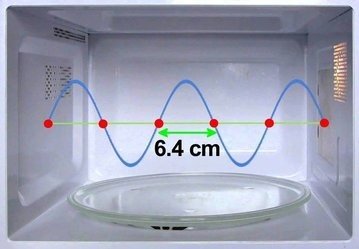Microwaves - The Physics
Few inventions have had an impact on everyday life like the microwave; tried and tested by the tight-scheduled, impatient and downright lazy, it has become a modern-day kitchen mainstay.
Yet the workings of such a familiar appliance remain, to many, an arcane mystery. It seems unjust that the science responsible for the 5-minute baked potato goes unacknowledged and unappreciated. Time to put that right...
Microwaves: Conducting Themselves Differently
Before the microwave, conventional ovens and stoves utilised convection and conduction (heat transfer from a heating filament to the air and among molecules in the food itself, respectively) to heat and cook. Heating in this way takes time, since heat must propagate first through the air before penetrating the food itself. This, and the fact that conventional conduction heating heats from the outside in - often burning the crust before sufficiently heating the centre - didn't sit well with 20th century impatience.
Good, old-fashioned supply-and-demand birthed the modern-day microwave oven.
Unlike its predecessor, the microwave heats using radiation. Rather than transferring heat among neighbouring molecules within a medium such as air, microwave ovens produce and propagate microwave radiation - which quite literally travels at light-speed - to penetrate and excite molecules within the chamber near-instantaneously.
The Magnetron
Despite the modest size (and price tag) of most modern microwave ovens, there's some relatively advanced physics beneath the surface. Of its components, the magnetron, the internal source of radiation, was by far the most groundbreaking.
A magnetron comprises two magnets flanking a copper ring, within which lies a copper rod. Coiled around the copper rod is a tungsten-thorium coil, which can withstand great heat and acts as a source of electrons.
A potential difference applied across the magnetron provides the rod with a negative charge (the rod is called a cathode) and the ring a positive charge (anode), creating an electric field in the vacuum separating the two components. When a current is passed through the coil, electrons 'boil' from the thorium and move through the electric field, unhindered by a medium, to the positively charged anode.
The permanent magnets create a magnetic field within which the copper ring, electric field and liberated electrons sit.
The two fields produce a net orthogonal force - Lorentz force - on the electrons (perpendicular to both fields), creating a 'pinwheel' of electrons which rotate around the lengthwise axis of the rod.

A magnetron uses interacting magnetic and electric fields to mobilise electrons, creating a source of electromagnetic radiation.
The negatively charged tips of the pinwheel pass over grooves cut into the inner surface of the positive copper ring, producing transient negative charges on the 'teeth' at regular intervals. These (temporarily negative teeth are surrounded by positively charged adjacent teeth and electromagnetic waves - microwaves - of a specific frequency (~2,500,000 Hz) are produced by the momentary, regularly oscillating electric fields.
Finally, an antenna at one end of the rod directs the radiation into the waveguide for delivery into the food chamber.
The Chamber
The waveguide directs coherent microwaves into the food chamber, where a standing wave is set up upon reflection at the metal walls, which ensure electromagnetic radiation does not leave the microwave.
Only standing waves which 'fit' half wavelength multiples into the microwave are permitted (see my article on standing waves here); for microwaves, this half-wavelength is ~6.4 cm.

Standing waves in microwave ovens measure about 6.4cm node-to-node.
The antinodes (peaks and troughs) correspond to points of high energy while nodes represent points at which molecules are not excited. Microwave turntables exist to reduce the number of 'cold spots' left by microwaves by moving the food away from nodes, with limited success.
This is (at least, partly) why there are often deceptively cool and scalding-hot regions of microwave-heated food, and why microwave-ready meal instructions insist you stir midway through heating.
Let's now consider why and how microwaves heat matter to begin with.
Polar Heat
Water molecules present in most foods are said to be polar as a result of uneven partial charge distributions within the molecule.

Electronegativity differences within the water molecule result in an uneven charge distribution.
Their dipole moment, which points in the direction of positive-to-negative charge, will align itself with (low energy) or against (high energy) the direction of the microwaves' oscillating electric field.

The orthogonal fields of electrostatic microwaves oscillate approximately 2,500,000 times a second.
The rapid 'flipping' of each polar water molecule disrupts transient intermolecular hydrogen bonding, causing a phenomenon analogous to friction between macroscopic particles. This excites (gives energy to) the molecules, heating, by conduction, the surrounding matter within the food.
This is the second-half of the 'cold spot' puzzle and explains why dry-packed and water-sparse foods do not heat up as effectively.
Fast Food For Thought
So the next time you find your mind wandering while your microwave does all the heavy lifting, spare a thought for the generations of apes who, without the cheat-codes of electromagnetism, slaved over an open flame for their Rustler burger, and Percy Spencer, without whose coffee-break chocolate bar we would too.

American physicist Percy Spencer found his Eureka moment as he walked past a primitive magnetron and the bar of chocolate in his pocket melted - a truly inspirational story of sacrifice in the name of science.
If you enjoyed this article and would like more, follow the everyday science blog for your daily dose of science.
References:
https://www.britannica.com
How Microwave Ovens Work - engineerguy
https://forecast.weather.gov
Percy Spencer: Courtesy Raytheon Company
